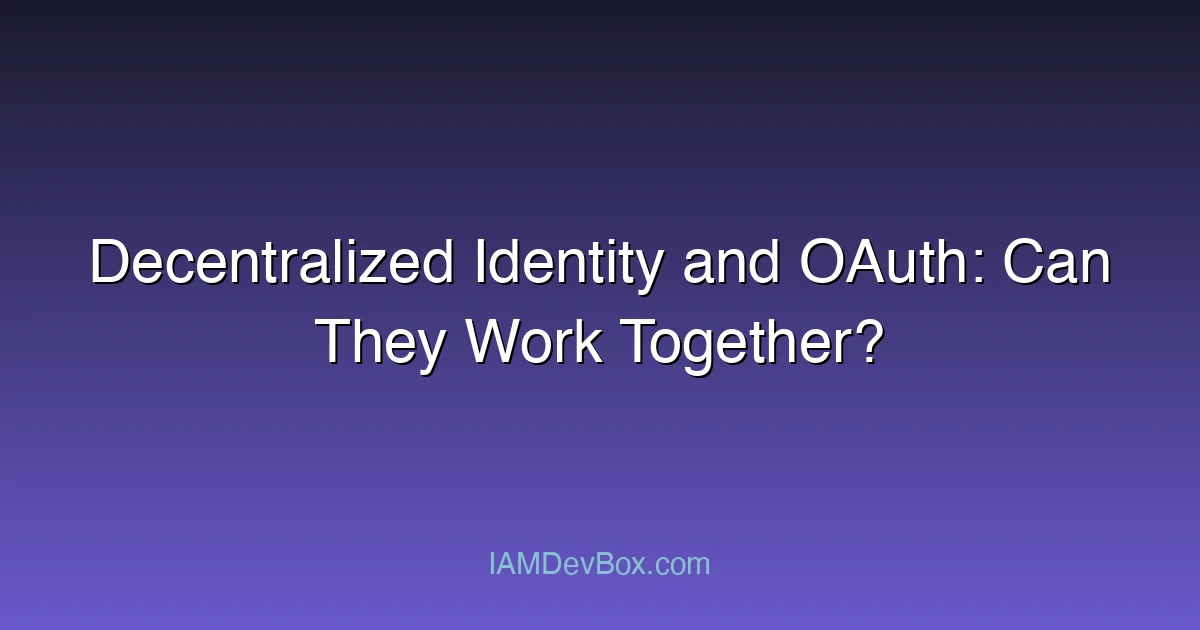Decentralized Identity (DID) represents a paradigm shift in digital identity, empowering users to control their identity data without relying on centralized authorities. But how does this emerging concept fit with OAuth, the dominant authorization framework used today?
What is Decentralized Identity (DID)?
DID enables identity holders to create and manage their digital identifiers independently, often leveraging blockchain or distributed ledger technologies. Unlike traditional identities stored on centralized servers, DID provides:
- User-centric control over identity data
- Portable and interoperable digital identifiers
- Verifiable credentials issued by trusted entities
OAuth’s Role in Today’s Identity Landscape
OAuth 2.0 primarily focuses on authorization—granting apps limited access to user resources. It relies on centralized Identity Providers (IdPs) for authentication and token issuance.
Challenges in Integrating DID with OAuth
- Decentralized Trust vs Centralized Tokens: OAuth tokens are typically issued by trusted IdPs. DID shifts trust to decentralized verifiers.
- Token Issuance: DID frameworks issue Verifiable Credentials (VCs) rather than OAuth access tokens.
- User Experience: Combining decentralized login with OAuth’s smooth app authorization requires careful UX design.
How Can They Work Together?
-
DID for Authentication, OAuth for Authorization Use DID-based authentication (e.g., via a DID wallet or agent) to authenticate users, then leverage OAuth to grant app access to APIs or resources.
-
OAuth Token Issuance from DID-Enabled IdPs Identity providers supporting DID can act as OAuth authorization servers, issuing tokens after verifying decentralized credentials.
-
Verifiable Credentials as OAuth Scopes or Claims VCs can be embedded in OAuth tokens as claims to convey verified identity attributes to relying parties.
Example Workflow
sequenceDiagram
participant User
participant DIDWallet
participant OAuthServer
participant API
User->>DIDWallet: Initiate DID Authentication
DIDWallet->>User: Request VC Presentation
User->>DIDWallet: Present Verifiable Credential
DIDWallet->>OAuthServer: Authenticate User via DID VC
OAuthServer->>User: Issue OAuth Access Token
User->>API: Access API with Token
This workflow preserves user control of identity while enabling existing OAuth-based apps to continue functioning.
Real-World Use Cases
- Healthcare apps verifying patient credentials via DID before authorizing access via OAuth tokens
- Financial services combining decentralized KYC with OAuth-secured APIs
- IoT ecosystems where devices use DIDs for identity and OAuth for resource access
Benefits of Integration
- Enhanced privacy and user control with decentralized identity
- Leverage mature OAuth infrastructure for API security
- Flexible, scalable identity architecture bridging Web2 and Web3
Next Steps for Developers
- Explore DID standards like W3C DID and Verifiable Credentials
- Experiment with OAuth extensions supporting VC claims
- Stay tuned for emerging hybrid identity platforms
👉 Related:
Understanding the Authorization Code Flow with PKCE in OAuth 2.0
OAuth 2.1: What’s Changing and Why It Matters
💡 Could decentralized identity transform the future of OAuth-based authentication? What challenges do you foresee in adoption?
